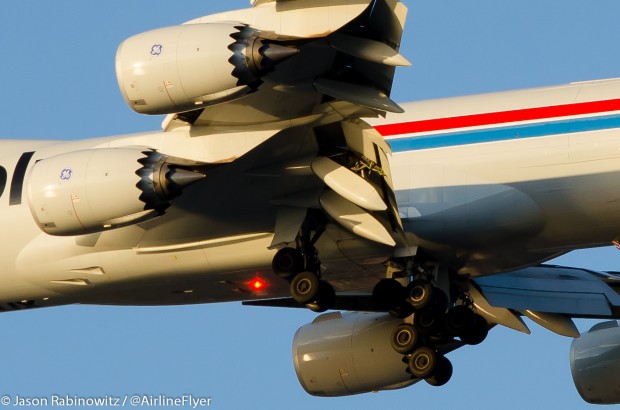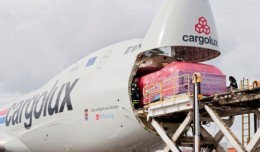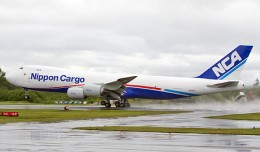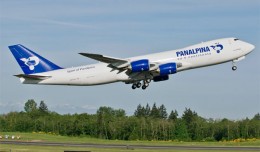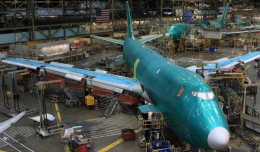In the Broadway Musical “Annie Get Your Gun”, Annie Oakley bellows in the final scene “Anything you can do, I can do better! I can do anything better than you!”
If airplanes could talk, I’m pretty sure that Boeing’s latest 747 variant, the B747-8F, would say the same thing to its predecessor! Let’s get something straight here, though. The B747-400, whether flown in a passenger or cargo configuration is a marvelous airplane. The -8F (referred to as the “Dash 8” on the line) is a revamped and much improved version of her older self. Apologies to “Dash 8” turboprop pilots for stealing the nickname but “The Ocho” wasn’t really going to work, although I did like it.
While the B747-8F certainty looks like a 747 with it’s distinctive upper deck, this latest variant is quite different beneath it’s exterior. In fact with a completely redesigned wing, enormous GEnx-2B engines, and almost 19 feet of increased length, it is quite different on the outside as well! Now that I think about it, the most similar item that they both share is how the pilots operate them. As you will see below, flying a -8F is very similar to flying a -400.
The B747-8F truly makes the management happy at the end of the day. When Boeing decided to develop a new 747, it was essential for it offer comparable costs per air-seat mile (ASM), especially when compared to the very efficient twin-engine airframes dominating the order book. In order to do that, Boeing completely redesigned the wing of the aircraft. The most obvious visual difference when compared to the -400’s wing is the swapping out of winglets for raked wing tips. The wingspan was also increased to 224’5”.
Much in line with the B787, the B747-8F has a Super Critical Wing. What a Super Critical Wing accomplishes is the reduction of drag through the minimization of a shockwave that forms on all sweptwing aircraft as they move through the air. The design of the wing on the -8F, allows lift to be developed further aft, which helps minimize the shockwave that forms. Since a smaller shockwave produces less drag, there is a need for less thrust and in return, a lower fuel burn for a given weight. However, not only does the B747-8F burn less fuel than a -400, but it does so at much higher weights. A loaded B747-8F at MGTOW tips the scales at 447.6T, or just shy of 985,000 lbs. This is about 77,000 lbs. more than its next closest predecessor, a B747-400ERF (Extended Range Freighter).
*In fact, as I sit here typing this, I have pulled up two flight plans for flights from Anchorage to Hong Kong. One is a B747-400F. The zero fuel weight (ZFW) is 177.3T and Fuel Burn for the whole flight is 82.6T. The other flight is a B747-8F. The ZFW is 215.7T and the Fuel Burn is 82.7T! The -8F is carrying 38.4T more weight and burning essentially the same amount of fuel! That is some serious performance improvement!
As remarkable as the wing is, it couldn’t do it all without superior engines. General Electric designed an enormously powerful and efficient engine with the GEnx-2B. This is essentially the same engine as that on the B787 except for some minor thrust rating and fan sizing differences. Surprisingly, the fan on the B787 is six inches larger in diameter than on the B747-8F. The GEnx-2B is rated at 66,500 pounds of thrust at takeoff settings and as we can see above, very fuel-efficient!
Not only has the outside of the aircraft been improved upon, so has the inside. The B747-8F takes a lot of technology from the B777 and incorporates it into the new design. Two of the biggest items are the Electronic Checklist (ECL) and the addition of Fly-By-Wire to some of the flight controls, both firsts in the B747 lineage. The electronic checklist is typically presented on the Lower EICAS display, but can be brought up on any of the screens that the pilot selects. The nice thing about the ECL is that it “knows” if items have been done and checks them off automatically. For instance, the last two items on the Landing Checklist are “Gear—Down” and “Flaps—30”. The ECL displays both items in green when they are in the proper position eliminating the need to verbally say the items. The system is quite easy to learn and is preferred in my opinion to flipping through the Quick Reference Handbook (QRH) looking for the correct checklist. The nice thing is that if there is an abnormal, the ECL will automatically bring up the correct checklist when the pilots need to action it.
A new feature to the 747 brand is the addition of fly-by-wire control to the outboard ailerons. All the other flight controls retain their previous design of being mechanically controlled and hydraulically powered. The outboard ailerons are hydraulically powered as well. One item that has changed on the -8F is the addition of aileron droop when the flaps are extended. The inboard ailerons droop when Flaps 10 or greater are selected and the outboard ailerons droop with Flaps 10 or 20.
Although not technically a fly-by-wire flight control, a very neat component of the -8F is the Flare Assist function. In order to have a common type for pilots to fly both the B747-400 and B747-8F, the flight characteristics have to be similar for both. The challenge was to take a much longer, much heavier, and more powerful aircraft and make it land using the same sight picture and feel as the B747-400. The answer is Flare Assist. The details of the system are not discussed in detail in our Operating Manuals, but from discussing the feature with some other pilots involved in the flight test program, the system essentially modulates the spoilers in order to give the -8F similar attributes as the -400 when coming in to land. Pretty neat stuff! From experience, I would say that Boeing has done a remarkable job. The landing process is almost exactly the same. The important thing to remember is that you may be carrying a whole lot more weight so the flare does need to be planned accordingly. Max Landing Weight in the -8F is 346T, or 761,000 pounds. That is quite an improvement over the B747-400F Max Landing Weight of 302T.
From a piloting perspective, the -8F handles and is operated quite similarly to a -400. A few differences involve the engine start procedure, as it is completely automatic. Pull the Start Switch and move the Fuel Control Switch to “Run” and the engine starts right up. We only manually abort a start in the event the Auto-start system fails.
Checklist usage is slightly different as previously discussed, but for the most part the actual checklists themselves are very similar to the -400. Taxing around the airport takes a little bit more over-steer than we are used to in the -400 as the main gear are about eight feet farther back on the -8F. Takeoff, climb out and all aspects of hand flying the aircraft are identical to the -400. The B747-8F does feel a little crisper when hand flying but that could just be because they are all brand new.
Descents need to be planned out a little more carefully especially when heavy and fast. It takes a lot of room to slow down, so ample planning is needed to be able to get down and slow down. The addition of a Vertical Situation Display (VSD) is a nice addition to help us plan our descents. This represents a side view of our descent profile against speed and altitude constraints, as well as terrain. It is an added level of information that takes some time to get used to, but displays some great information when descending to land. Landing the airplane is done in a similar fashion as the -400 and with the Flare Assist you would never know the difference.
Another improvement is the way we fly Non-Precision Approaches. In the B747-400 we typically used LNAV/VNAV, or LNAV/Vertical Speed modes to fly the approach. In the B747-8F, as long as all the altitude restrictions are programmed correctly, we can push one single button, the APP button, and the autopilot will fly the procedure just like an ILS. The Flying Pilot can also hand fly using the Flight Directors if they so choose. While flying a Non-Precision Approach previously was not difficult, this system eliminates some of the procedural steps that were involved, making the entire operation safer.
Overall, the B747-8F is a fabulous aircraft not only from a piloting perspective, but also from an engineering and revenue management perspective. Boeing has really designed a completely new aircraft while utilizing some of the technology that worked from the previous generation 747’s. There are obviously many more differences between the B747-400 and the B747-8F than from what I’ve presented here, but I wanted to give a basic overview of those differences from a piloting and design perspective. I’m very fortunate to fly this new aircraft on a regular basis and the only thing I can hope for at this point are a few orders for the Intercontinental, the B747-8I passenger ship!
Although the B747-400 is an amazing aircraft, the “New Classic” has given way to a newer, more improved relative. I would say we could all agree with Annie Oakley when it comes to the B747-8F!
“Anything you can do, I can do better!”
Justin Schlechter is an airline pilot that lives on Long Island with his family. If you would like to see Long Island from the air with him, visit flysouthshore.com.




